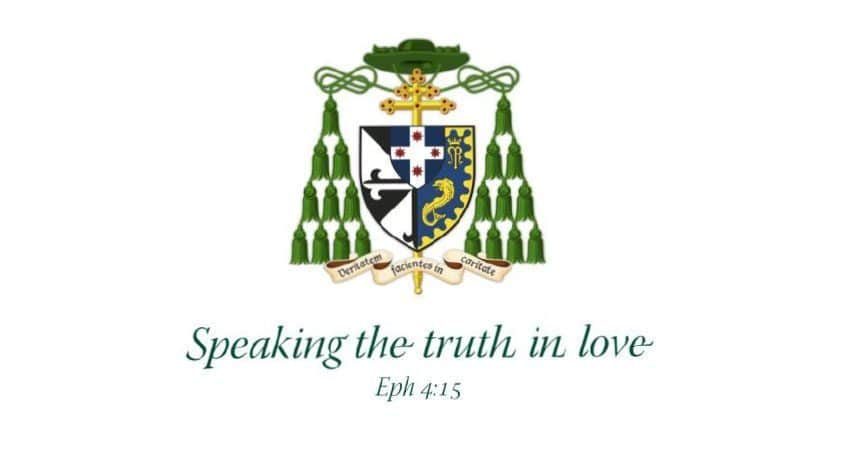Homily for the Midnight Mass of the Nativity of the Lord

St Mary’s Basilica, Sydney, 25 December 2022
“He loves me, he loves me not, he loves me, he loves me not,” so the game goes as petal after petal is plucked from a daisy until the last petal answers the question. The history of ‘the Daisy Oracle’ has been traced through 19th-century classics such as Goethe’s Faust (1808) and Adam’s ballet Giselle (1841) back to the songbook of a 15th-century German nun (Clara Hätzlerin 1471) and before.[1] On the face of it, it’s just childish fun or playful superstition. But it also reflects something deeper about human beings: however misguided our searches sometimes are, we long to love and be loved, and to distinguish truth from falsehood.
That human beings are hardwired for truth and love is very much the Christian story. The Book of Genesis says we are made in the image and likeness of God (Gen 1:27), and that this dignifies us beyond all material creation. But as the Bible unfolds it’s clear that in so many ways we are NOT like God: God is necessary, self-existent, all-powerful, infinite, immutable, impassible, eternal, whereas we are contingent, derivative, vulnerable, limited, changeable, susceptible, mortal. God is perfectly faithful and loving, merciful and just; we are at best only imperfectly so. Logic and experience may tell us there’s a god and something of what God is, but they don’t tell us much about who God is: indeed, to say God is Holy is to say God is quite Other than us.
In the end it’s up to God to show Himself to us. He gave our Jewish forefathers various hints, confirming that He is a “Wonder-Counsellor, Mighty-God, Eternal-Father, Prince-of-Peace” (Isa 9:1-7). He revealed something of His mercy and will. In our yearning to love and be loved, to know what is true and good and beautiful, He explained we are imaging His own inner life. But to know and love Him, in a way that would redeem us and unite us to Him forever, would require Him to enter our time and space, history and experience, and that seemed impossible.
The nineteenth century Danish philosopher, Søren Kierkegaard, told a story of a powerful king who loved a lowly maiden.[2] How could the king be sure she loved him in return, for his own sake, and not just for his riches or out of fear? The gulf between them seemed to affirm the ancient wisdom that friendship is only possible between approximate equals. Of course, the king could make her a duchess or princess, but that would testify more to his power than his love. He could disguise himself and woo her as a beggar, but true love can’t be based on deception. All that was left to him was to renounce his throne and riches, and become a true beggar. At Christmas God reduces Himself to our level, so we might truly know and love Him as our equal!
Kierkegaard’s parable is imperfect of course: in the Incarnation the Son of God certainly empties himself, taking on the form of a servant (Phil 2:6-8). But he also remains the King, the Son of God.[3] And He also raises the maiden, making the Church His bride and all of us His royal siblings, partakers in His divine nature (2Pet 1:4; 1Jn 3:2). He had three options and chose all three!
Two thousand years ago, at the first Christmas, God revealed Himself to us in a way that seemed impossible. The necessary Creator took the form of the contingent creature; the all-powerful and infinite assumed the vulnerability and limitations of a child; the eternal, immutable and impassible would change, hunger and thirst, suffer and die. The totally Other is now totally Us: with us, for us, in us. We are known and loved by God from the inside, and can know and love Him back. Something the patriarchs and prophets, philosophers and potentates never saw, is seen by Mary and Joseph, shepherds and us: God, not fearful or abstract, but intimate, personal, a baby.
After a year of disastrous flood in this state and terrible war in Ukraine and elsewhere, how we can talk of a God who cares? How do we speak of light to those whose darkness includes lost loved ones, homes and livelihoods? Having this year lost both parents with whom I’ve spent the last 62 Christmases, what do I say to my family or myself?
At Christmas we can join the closed-hearted innkeeper, the cruel and deceitful dictator Herod, the soldiers going with the flow even if it hurts others. Or we can join the shepherds hearing the music of the heavens and rumour of angels, the magi responding to the wonders of nature and wisdom of the ages, the young couple following God’s call wherever it takes them. Amidst man and nature at their worst, Christmas reveals God to us, but also human beings at their most God-like. Many Eastern churches celebrate Christmas according to the old calendar, on 7th January; but this year in Ukraine they will join the West in celebrating today, in a sign that hatred from one direction can drive new friendships in another. Despite the grim determination of their oppressors and their courage as victims, Ukrainians are talking of Christmas truces and good will in this holy season. For Christmas speaks to the human heart, infused by divine grace, that refuses to give in to the darkness but sees a great light; that hears the music of heaven in a baby’s cry and joins the choirs singing for joy; that craves love and truth and hopes these will break out again on this holy day (cf. Isa 9:1-7; 52:7-10; Lk 2:1-14; Jn 1:1-18).
He loves me, He loves me not, He loves me, He loves me not: the petals are plucked, the answer is in, in a petal the shape of a newborn Baby. God loves you. You are loved from all eternity to all eternity!
Word of Thanks after the Midnight Mass of the Nativity of the Lord
St Mary’s Basilica, Sydney, 25 December 2022
My thanks to all those who have contributed to today’s beautiful celebration of the Nativity of the Lord. Our Master of Ceremonies Fr Lewi Barakat, Dean Don Richardson, Precinct Manager Helen Morassut and Cathedral Sacristan Chris Backhouse, with their teams of priests and deacons, ministers and readers, ushers, staff and volunteers, ensure that our liturgical and devotional life are worthy, not just at Christmas, but all year round.
Our wonderful choir and organists have enabled us to join the angels singing glory to God on high and peace to people here below, as they do all year round. Many other people assist in the daily life of this great cathedral, and I thank them all. One, in particular, I want to pick out: our Director of Music, Thomas Wilson, who bids us farewell after 13 years at the helm of the St Mary’s Cathedral Choir. Thomas, you have done so well in raising this choir to international standard and raising our hearts and minds to God in the process. You have lent us your qualifications, vision and energy in bringing choirs, orchestras and organists together in service of the liturgy. You have enormously expanded the repertoire of the cathedral choir and congregation. You’ve been an excellent teacher and mentor and taken the choir on world tours. You’ve shared your faith with the boys, the lay clerks and indeed this congregation through your music.
The Dempsey Medal celebrates those who have significant contributions to building up the Church in Sydney through their acts of service. It is named for James Dempsey, a prominent lay leader in the early convict period of our city. He offered his home as a gathering place for the much-maligned Catholic community, promoted catechesis and prayer before the arrival of priestly leadership, accompanied the condemned to the gallows, helped establish the first St Mary’s on this site, and gave glory to God in that chapel where our present choir was first established. Today we honour a successor lay leader and benefactor of God’s people and of this cathedral, Mr Thomas Wilson.
Finally, I know that some of you are regulars here; others less frequent; some, visitors from overseas, interstate, other parishes, even other faith traditions. Please know that you are always welcome at St Mary’s. On behalf of all of us at St Mary’s Cathedral, I wish you and your loved ones every blessing of this holy season of Christmas and of the New Year of Grace 2023.
[1] Carrie Collenberg-González, “The daisy oracle: a new Gretchenfrage in Goethe’s Faust,” Goethe Yearbook 28 ( 2021): 125-39; Malcolm Jones, The Secrets of the Middle Ages: Discovering the Real Medieval World (London: Praeger, 2003), 205; Wolfgang Mieder, “Modern variants of the daisy oracle ‘He loves me, he loves me not’,” Tradition and Innovation in Folk Literature Routledge, 1987), ch. 3.
[2] Soren Kierkegaard, Philosophical Fragments or A Fragment of Philosophy by Johannes Climacus, translated by Howard V. Hong (New Jersey: Princeton University Press, 1962)
[3] Mt 14:33; 16:16; 27:43,54; Mk 1:1; 9:7; Lk 1:32-35; 4:4; Jn 1:34; 11:27; 14:7-9; 19:7 etc.
Introduction to the Mass of the Day of the Nativity of the Lord – St Mary’s Basilica, Sydney, 25 December 2022
People of Sydney I bring you news of great joy, a joy to be shared by all people: today in the city of David a Saviour has been born to you: He is Christ the Lord (Lk 2:11).
Welcome to St Mary’s Cathedral for our celebration of the Nativity of the Lord. I offer this Mass with you and for you, and for all your loved ones, that you may experience the glory of God above and the peace of people here below.
That we might receive the Christ-child into the crib of our hearts this Christmas, and receive the Apostolic Blessing with Plenary Indulgence under the ordinary conditions, let us repent of our sins and ask Christ to make us anew…

